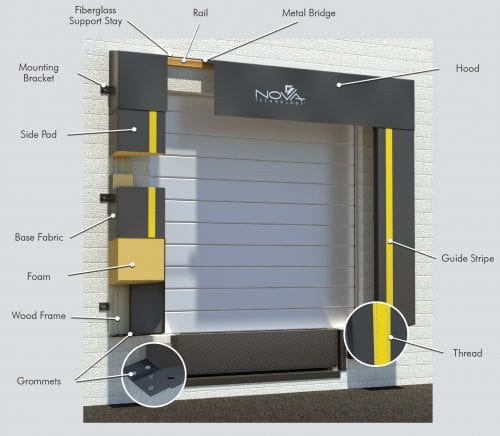Loading Dock Inspections

The inspection of manufacturing, industrial, or some office spaces, often include a loading dock feature. This is the means for which deliveries flow to and from the building. Industrial or shipping buildings could have dozens of docks spread across the building campus. A professional commercial building inspector has to have an understanding of how a loading dock works and what failures or safety issues exist. 
In order to understand more about loading docks, there has to be an understanding of the various parts, components and types of loading docks. Some loading docks are just a raised platform to the height of a standard truck allowing the load to easily move on and off the truck. There is the depressed dock where the dock is lower than the interior floor and the truck has to back downward in order to load or unload. Lastly, there is the raised dock. This type of dock uses a raised ramp to bring the load up to a door, but since the load is higher than the floor an unloading vehicle has to remove the load from the truck.
Regardless of the type of ramp or dock, if there is an opportunity to have a truck, trailer, or any other machinery come into contact with the building, bumpers and bollards are used. The bumper protects the blunt force impact from direct impact. A bumper can also be used as the resting end so the driver knows when to stop. A bollard is the vertical post, often painted bright yellow and placed at corners, or other potential impact points. Bollards are often the first line of defence from building or system impact.
Not all trucks or trailers are the same height. The finished height of the building floor is static so a dock leveler has to be used to help bridge that gap. This device is often constructed of steel and utilizes compressed air, hydraulic pumps, or mechanical springs to move the plates up and down or in and out. The mechanical leveler is the most common because it does not require electricity or any other powered equipment.
Not all trucks or trailers are the same height. The finished height of the building floor is static so a dock leveler has to be used to help bridge that gap. This device is often constructed of steel and utilizes compressed air, hydraulic pumps, or mechanical springs to move the plates up and down or in and out. The mechanical leveler is the most common because it does not require electricity or any other powered equipment.
A serious safety concern for dock workers is the unwanted or unannounced trailer departure. This is when the trailer is removed from the dock without notice. A dock worker inside of the truck can fall from the trailer because they will be under the belief that the trailer and dock are still on the same level or stationary. When a truck restraint system is installed, the trailer will not be able to be separated from the dock until all personnel are altered or in a safe location.
Docks and ramps are often depressed on raised platforms. These can have as much as a five foot rise or fall. Without some form of guard or hand railing, this varied height can cause huge safety concerns. A properly installed railing will protect the entire length of the dock. A bollard should be installed to protect the railing or concrete retaining walls from impact.
Depressed loading docks or loading docks built into the building at a height lower than the finished floor typically have drains installed at the bottom of them. These could be simple drains directly plumbed into the storm or sewer system or plumbed into a sump system and pumped into an appropriate location.
Now that there is an understanding of loading docks, what does an inspector have to report on or inspect. Every inspector will have a different experience level or, through proposal, create a different client expectation, but the same basic safety observations and function notes should be made.
Any failures in the concrete surfaces or walls should be noted. Wherever there is an opportunity to protect personnel from falling, guard or hand railings should be placed. If there is a location where a trailer or vehicle can come into contact with the building or dock feature, a bollard should be installed. Any mechanical, weather, or other damage present to the shetlers and seals should be identified. Most inspectors are not going to operate or inspect levelers but identifying the locations will be of benefit to your clients. Flooding is always a concern to your clients. Locating the drain in the bottom of the ramp and locating the direction of where the drain is going should be part of the inspection. The sump system, if present, should be operated as well.
Regardless of to what extent you inspect a loading dock, your clients will appreciate photos of the various elements and systems present and the visual condition at the time of the inspection.